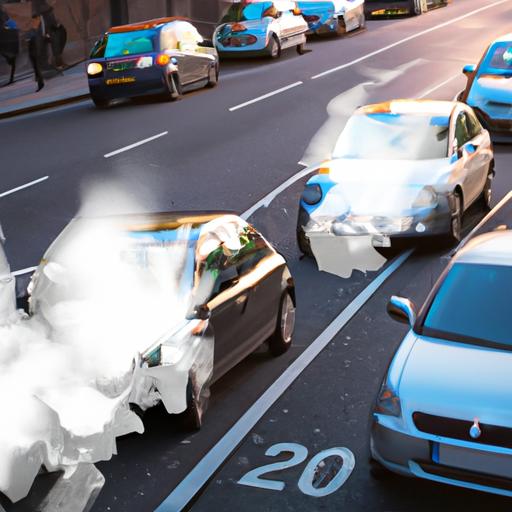Introduction
As we navigate through bustling city streets or embark on long scenic drives, cars have become an integral part of our modern lives. However, it’s important to take a moment and consider the environmental impact of these vehicles. One question that often arises is, “do cars release carbon dioxide?” In this article, we will delve into the world of car emissions, focusing on carbon dioxide as a significant contributor. By understanding the implications of carbon dioxide emissions from cars, we can take steps towards a greener future.
The environmental consequences of cars cannot be ignored. From air pollution to climate change, these vehicles play a substantial role in altering our planet’s delicate balance. Therefore, it is crucial to comprehend the intricacies of car emissions and their impact on our environment.
Understanding car emissions goes beyond mere curiosity. It allows us to be more aware of the choices we make as consumers and the actions we take to reduce our carbon footprint. By exploring the main keyword, “Do cars release carbon dioxide,” we can shed light on an essential aspect of car emissions and its wider implications.
In the following sections, we will dive into the details of carbon dioxide emissions from cars, their effects on the environment, and measures that can be taken to mitigate their impact. Let’s embark on this journey together and explore the world of cars and carbon dioxide emissions.
Understanding Car Emissions
Different Types of Emissions from Cars
When it comes to car emissions, it’s crucial to understand that they encompass more than just carbon dioxide. Cars release a range of pollutants into the environment, including nitrogen oxides (NOx), particulate matter (PM), volatile organic compounds (VOCs), and carbon monoxide (CO). Each of these emissions has its own detrimental effects on both human health and the environment.
Major Contributors to Car Emissions
While cars contribute to various emissions, certain factors play a significant role in their overall impact. The combustion of fossil fuels, such as gasoline and diesel, is a primary source of emissions from cars. Additionally, the age and condition of the vehicle, driving habits, and traffic congestion all influence the amount of emissions produced.
Role of Carbon Dioxide in Car Emissions
Carbon dioxide (CO2) is a greenhouse gas that is released when fossil fuels are burned. In the context of car emissions, carbon dioxide is one of the most prominent contributors. As cars burn fuel to generate energy for propulsion, carbon dioxide is emitted into the atmosphere. These emissions accumulate over time and contribute to the greenhouse effect, leading to global warming and climate change.
It is essential to grasp the significance of these different emissions and their specific effects. By understanding the various types of emissions from cars, identifying the major contributors, and recognizing the role of carbon dioxide, we can develop a comprehensive understanding of the environmental impact of cars. In the subsequent sections, we will delve deeper into the specifics of carbon dioxide emissions, their consequences, and potential solutions to reduce their harm.
Carbon Dioxide Emissions from Cars
Explanation of Carbon Dioxide as a Greenhouse Gas
To understand the significance of carbon dioxide emissions from cars, it’s crucial to grasp the role of carbon dioxide as a greenhouse gas. Carbon dioxide, often abbreviated as CO2, is a naturally occurring gas that is released during the combustion of fossil fuels such as gasoline or diesel in car engines. This gas has the ability to trap heat in the Earth’s atmosphere, contributing to the greenhouse effect and subsequently leading to global warming.
As cars burn fossil fuels, they release carbon dioxide into the atmosphere, adding to the overall concentration of greenhouse gases. This increase in greenhouse gases intensifies the greenhouse effect, resulting in a rise in global temperatures. The consequences of this temperature rise are far-reaching, including the melting of ice caps, rising sea levels, and extreme weather events.
Sources of Carbon Dioxide Emissions in Cars
The primary source of carbon dioxide emissions in cars is the burning of fossil fuels. When we fill up our gas tanks and drive our vehicles, the combustion process releases carbon dioxide as a byproduct. In fact, transportation is one of the largest contributors to carbon dioxide emissions globally, accounting for a significant portion of total greenhouse gas emissions.
Additionally, factors such as the fuel efficiency of the vehicle, driving habits, and maintenance practices also influence the amount of carbon dioxide emitted by cars. Older vehicles and those with poor fuel efficiency tend to release higher levels of carbon dioxide, exacerbating the environmental impact.
Factors Affecting Carbon Dioxide Emissions from Cars
Several factors come into play when considering the amount of carbon dioxide emitted by cars. Firstly, the type of fuel used plays a crucial role. Traditional gasoline-powered vehicles tend to emit more carbon dioxide compared to hybrid or electric vehicles. The fuel efficiency of the vehicle is another critical factor. Cars with higher fuel efficiency release less carbon dioxide per mile traveled.
Moreover, driving behavior and maintenance practices also impact carbon dioxide emissions. Aggressive driving, excessive idling, and failure to maintain the vehicle’s engine and exhaust system can lead to increased emissions. By adopting eco-friendly driving habits and ensuring regular vehicle maintenance, we can contribute to the reduction of carbon dioxide emissions from cars.
In the next section, we will explore the implications of carbon dioxide emissions and their impact on the environment, particularly in relation to global warming and air pollution.
Impact of Carbon Dioxide Emissions
A. Global Warming and Climate Change Connection
When it comes to the impact of carbon dioxide emissions from cars, one of the most significant concerns is their contribution to global warming and climate change. Carbon dioxide, along with other greenhouse gases, traps heat in the Earth’s atmosphere, leading to an increase in the average global temperature. This phenomenon, known as global warming, has far-reaching consequences for our environment and ecosystems.
As cars release carbon dioxide into the atmosphere, the concentration of this greenhouse gas increases, intensifying the greenhouse effect. The consequences of global warming are profound, resulting in rising sea levels, melting polar ice caps, extreme weather events, and shifts in ecosystems. The connection between carbon dioxide emissions from cars and global warming highlights the urgent need to address and reduce these emissions.
B. Negative Effects of Excessive Carbon Dioxide Emissions
Excessive carbon dioxide emissions from cars have detrimental effects on both the environment and human health. The accumulation of carbon dioxide contributes to the overall increase in greenhouse gases, leading to a warmer climate. This, in turn, disrupts weather patterns, causing more frequent and severe storms, droughts, and heatwaves.
Moreover, the excessive presence of carbon dioxide in the atmosphere alters ocean chemistry, leading to ocean acidification. This can have devastating consequences for marine life, including coral reefs, shellfish, and other organisms that rely on calcium carbonate for their structures and shells.
C. Role of Carbon Dioxide in Air Pollution
While carbon dioxide itself is not considered a harmful air pollutant, its association with other pollutants leads to air pollution. When fossil fuels are burned in car engines, they release not only carbon dioxide but also pollutants such as nitrogen oxides and particulate matter. These pollutants contribute to poor air quality and can have adverse effects on respiratory health, particularly in densely populated areas with high traffic volumes.
The role of carbon dioxide in air pollution is a complex one, as it is intertwined with other emissions from cars. By understanding the connection between carbon dioxide and air pollution, we can develop strategies to mitigate and reduce the overall environmental impact of car emissions.
In the following sections, we will explore measures that can be implemented to decrease carbon dioxide emissions from cars and promote sustainable transportation alternatives. Stay tuned as we unravel the path to a greener future.
Measures to Reduce Carbon Dioxide Emissions
The impact of carbon dioxide emissions from cars can be mitigated through various measures. By adopting eco-friendly car technologies, promoting fuel efficiency, and implementing policy interventions, we can make significant strides towards reducing carbon dioxide emissions and creating a more sustainable future.
A. Introduction to Eco-Friendly Car Technologies
In recent years, there has been a surge in the development and adoption of eco-friendly car technologies. Electric vehicles (EVs) have emerged as a promising alternative to traditional gasoline-powered cars. These vehicles produce zero tailpipe emissions, effectively eliminating carbon dioxide emissions during operation. As EV technology continues to advance and infrastructure improves, transitioning to electric vehicles can have a profound impact on reducing carbon dioxide emissions from the transportation sector.
Hybrid vehicles offer another eco-friendly option. By combining an internal combustion engine with an electric motor, hybrids can significantly improve fuel efficiency and reduce carbon dioxide emissions. These vehicles utilize regenerative braking, which converts kinetic energy into electricity, further reducing the reliance on fossil fuels.
B. Promoting Fuel Efficiency and Alternative Fuels
Improving fuel efficiency in conventional vehicles is another crucial aspect of reducing carbon dioxide emissions. Car manufacturers are continuously working towards developing more fuel-efficient engines and optimizing vehicle designs. By embracing fuel-efficient cars, we can reduce the amount of fossil fuels burned and subsequently minimize carbon dioxide emissions.
Additionally, exploring alternative fuels can have a positive impact on carbon dioxide emissions. Biofuels, such as ethanol and biodiesel, are derived from renewable sources and have lower carbon content compared to conventional fuels. Supporting the production and use of biofuels can help reduce carbon dioxide emissions while diversifying the energy sources for transportation.
C. Policy Interventions and Regulations to Reduce Emissions
To accelerate the reduction of carbon dioxide emissions from cars, policy interventions and regulations play a vital role. Governments around the world are implementing measures such as fuel efficiency standards, emission limits, and incentives for eco-friendly vehicles. These actions encourage both car manufacturers and consumers to prioritize sustainability and make choices that reduce carbon dioxide emissions.
In addition to governmental initiatives, international agreements like the Paris Agreement have set targets to combat climate change. These agreements aim to reduce greenhouse gas emissions, including carbon dioxide from the transportation sector. By adhering to these agreements and implementing effective policies, we can collectively work towards a future with lower carbon dioxide emissions from cars.
By embracing eco-friendly technologies, promoting fuel efficiency, and implementing supportive policies, we can make significant progress in reducing carbon dioxide emissions from cars. It is crucial for individuals, governments, and industries to collaborate and prioritize sustainability to pave the way for a greener and more environmentally conscious future.
Conclusion
In conclusion, understanding the role of cars in releasing carbon dioxide is crucial for addressing the environmental challenges we face today. Cars are one of the leading contributors to greenhouse gas emissions, particularly carbon dioxide. These emissions have far-reaching consequences, ranging from global warming and climate change to air pollution and its detrimental effects on human health.
By recognizing the impact of carbon dioxide emissions from cars, we can take steps towards reducing our carbon footprint and promoting sustainable transportation alternatives. Embracing eco-friendly car technologies, such as electric vehicles and hybrids, along with promoting fuel efficiency and alternative fuels, can significantly reduce carbon dioxide emissions.
It is a collective responsibility to adopt policies and regulations that encourage the use of greener transportation options. Governments, organizations, and individuals must work together to create a future where cars release minimal carbon dioxide into the atmosphere. Additionally, initiatives like carpooling, public transportation, and biking can play a role in reducing our reliance on carbon-emitting vehicles.
As we strive for a greener and more sustainable world, let us remember that every action we take matters. By choosing environmentally friendly transportation options and supporting efforts to reduce carbon dioxide emissions, we can make a positive impact on our planet and future generations.
So, the next time you ask yourself, “Do cars release carbon dioxide?” remember the importance of this question and the power we hold to drive change. Together, let’s steer towards a cleaner, healthier, and carbon-neutral future.



